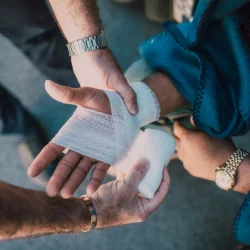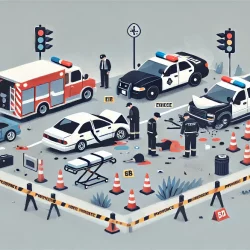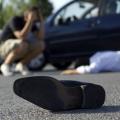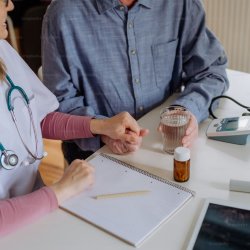Tips for Documenting Evidence After a Car Crash
A car crash is one of those moments that can shake you to your core. Whether it's a minor fender-bender or something more serious, your mind races with questions. Is everyone okay? What just happened? What do I do next?
One of the most important things you can do in those first moments after a crash once you’re safe—is to start documenting what happened. The evidence you gather could be essential if you need to file an insurance claim or take legal action later, visit this page. But don’t worry if you’re not sure where to start. This guide will walk you through the steps of documenting evidence after a car crash, so you feel a little more prepared if you ever find yourself in that situation.
Stay Safe First
Before you even think about pulling out your phone or talking to witnesses, take a deep breath and assess the situation. Make sure you, your passengers, and anyone else involved are okay. If there are injuries, call 911 immediately. Safety comes first, always.
If it’s safe to do so, move your vehicle out of traffic to avoid further accidents. Turn on your hazard lights, and if you have road flares or cones, set them out to alert other drivers.
Call the Police
Even in a minor accident, it’s a good idea to call the police. An official report can be a valuable piece of evidence, especially if the other driver tries to change their story later. The police will document the scene, gather witness statements, and create a crash report that you can request later.
When the officers arrive, stick to the facts. Don’t guess or speculate about what happened. Just tell them what you know for sure.
Take Photos of Everything
Your smartphone is your best friend in a crash. Use it to capture as many clear photos as you can. Here’s a quick checklist of what to photograph:
- All vehicles involved, from multiple angles
- Visible damage to the cars
- License plates
- The surrounding area, including traffic signs or signals
- Road conditions (wet, icy, potholes, etc.)
- Any skid marks or debris
- Injuries (if appropriate and with consent)
- Weather and lighting conditions
Try to take both close-up and wide shots. You want to capture the overall scene, but also focus on the details that might support your version of events.
Exchange Information (Politely)
You’ll need to exchange information with the other driver, but keep things calm and respectful. Emotions can run high after a crash, but losing your cool won’t help. Be polite, and stick to the essentials.
Here’s what to get:
- Full name and contact info
- Insurance company and policy number
- Driver’s license number
- License plate number
- Vehicle make, model, and color
Also, note the number of passengers in each vehicle and their names, if possible.
Talk to Witnesses
If anyone nearby saw what happened, their statements could help support your account of the crash. Ask for their names and contact information. If they’re willing, have them give you a quick recorded statement on your phone describing what they saw.
Make sure to thank them for their time. A neutral third-party witness can go a long way in backing up your story if there’s a dispute later.
Jot Down Notes While It’s Fresh
Details can get fuzzy fast, especially when adrenaline is pumping. As soon as you can, take a few minutes to jot down everything you remember about the crash. Include:
- Time and date
- Location of the accident
- What direction you and the other vehicle(s) were heading
- Estimated speeds
- What you saw or heard before, during, and after the crash
Even small details can be helpful later, and writing them down while they’re still fresh in your mind ensures you won’t forget something important.
Don’t Admit Fault
It’s natural to want to apologize, especially if the crash was scary or someone is hurt. But saying “I’m sorry” can be taken as admitting fault, even if you weren’t actually responsible.
Stick to the facts, and avoid making statements about who was at fault. Leave that determination to the insurance adjusters and police. Your job is to document and report what happened as clearly and accurately as possible.
Get a Copy of the Police Report
Once the responding officers file their report, you can request a copy from the local law enforcement agency. This report will include key information like the officer’s observations, statements from those involved, and sometimes even a diagram of the crash scene.
This official documentation can be a powerful piece of evidence, especially if your case ends up going to court or you’re dealing with a tough insurance claim.
Seek Medical Attention
Even if you feel okay, it’s smart to get checked out by a medical professional after a crash. Some injuries—like whiplash, concussions, or internal injuries, might not show symptoms right away. Having medical records that show you sought treatment right after the accident helps connect any injuries to the crash.
Plus, your health and well-being are what matter most. Don’t wait until things get worse.
Store Everything in One Place
Once you’ve gathered all your evidence, keep it organized. Create a digital or physical folder where you store:
- Photos and videos from the crash
- Contact information for everyone involved
- Police report
- Witness statements
- Your notes
- Medical records or bills
- Correspondence with insurance companies
Having everything in one place makes it easier if you need to reference something later. It also shows you were thorough and proactive, which can help your case.
Final Thoughts
Being in a car crash is scary and overwhelming, but taking the time to properly document what happened can make a huge difference in the aftermath. Whether you’re dealing with insurance, legal claims, or just trying to make sense of it all, having solid evidence puts you in a better position.
The key is to stay calm, be observant, and act quickly. You don’t need to be a professional investigator just a person who’s looking out for themselves and doing their best to protect their rights.
Hopefully, you’ll never need to use this advice. But if you do, you’ll be glad you knew what to do when it mattered most.
More to Read:
Previous Posts:




